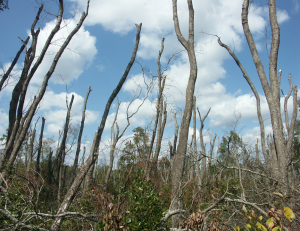
The invasive Asian longhorned beetle, is a wood-boring insect that kills hardwood trees. Guo’s study tested for potential correlations between feeding habits and forest fragmentation. Photo by R. Anson Eaglin, USDA APHIS.
Managing invasive species is one of the largest challenges that land managers face. They threaten the health of natural ecosystems, prevent the growth of native species, and leave landowners with significant amounts of damage.
“More than 4,300 exotic plant species and 66 foreign pest species that can cause negative effects on forest ecosystems and economies have been found in the United States,” says USDA Forest Service research ecologist Qinfeng Guo. “While not all nonnative species are equally invasive, many are especially adaptive to new environments and can quickly dominate them.”
Humans are largely responsible for increasing the range and distribution of pest species. As people continue to change the landscape by converting forest land for development, agriculture, and other uses, scientists are trying to understand the effect that such fragmentation will have on forest ecosystems, including their susceptibility to invasive pests.
Guo, who specializes in the study of biological invasions, collaborated with SRS scientist Kurt Riitters and North Carolina State University researcher Kevin Potter to examine the effects that different types of fragmentation and forest edges can have on forest pest invasions. Their results were published in the journal Forests.
They pulled together existing data on land use and pest richness from across the continental U.S. and categorized different types of forest edge. A forest edge was understood as a piece of forest that borders another land type, as opposed to a forest core which borders only forested land. For example, an edge could be classified as a “forest: agriculture” or “forest: grassland” edge. This way, the researchers could separate the correlation between each edge type and pest numbers.
Forests bordering developed land – areas such as roads, housing, or industry – were correlated with higher numbers of pest invasions. This supported the current understanding that humans are a primary source of pest mobility. In contrast, forests fragmented by agricultural or grassland were not correlated with more invasions.
“Forest pests don’t have much use for agricultural land,” explains Guo. “And grass pests are different than forest pests, so they also pose little threat to forests.”
Invasion rates varied among the pests. Specialist species, those with specific diets, are generally more responsive to fragmentation than are generalists, those with a varied diet. And pathogens – disease causing microorganisms – are less sensitive to fragmentation than are insects, likely because pathogens trend to spread easily.
For more information, and a sound recording of Qinfeng Guo describing this research, see this blog posting from the U.S. Forest Service Southern Research Station.
July 12, 2019




